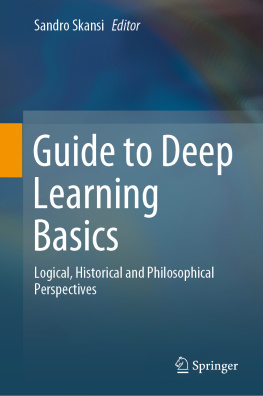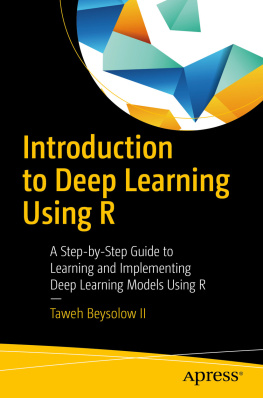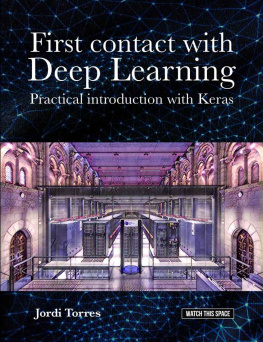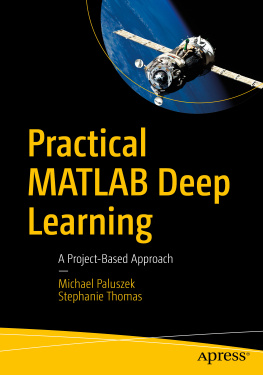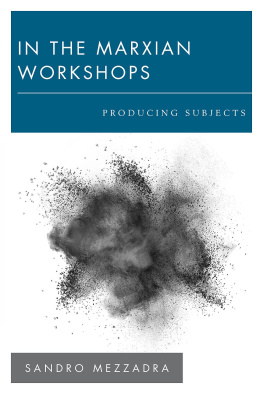Sandro Skansi - Introduction to Deep Learning
Here you can read online Sandro Skansi - Introduction to Deep Learning full text of the book (entire story) in english for free. Download pdf and epub, get meaning, cover and reviews about this ebook. year: 0, publisher: Springer International Publishing, genre: Romance novel. Description of the work, (preface) as well as reviews are available. Best literature library LitArk.com created for fans of good reading and offers a wide selection of genres:
Romance novel
Science fiction
Adventure
Detective
Science
History
Home and family
Prose
Art
Politics
Computer
Non-fiction
Religion
Business
Children
Humor
Choose a favorite category and find really read worthwhile books. Enjoy immersion in the world of imagination, feel the emotions of the characters or learn something new for yourself, make an fascinating discovery.
- Book:Introduction to Deep Learning
- Author:
- Publisher:Springer International Publishing
- Genre:
- Year:0
- Rating:3 / 5
- Favourites:Add to favourites
- Your mark:
- 60
- 1
- 2
- 3
- 4
- 5
Introduction to Deep Learning: summary, description and annotation
We offer to read an annotation, description, summary or preface (depends on what the author of the book "Introduction to Deep Learning" wrote himself). If you haven't found the necessary information about the book — write in the comments, we will try to find it.
Introduction to Deep Learning — read online for free the complete book (whole text) full work
Below is the text of the book, divided by pages. System saving the place of the last page read, allows you to conveniently read the book "Introduction to Deep Learning" online for free, without having to search again every time where you left off. Put a bookmark, and you can go to the page where you finished reading at any time.
Font size:
Interval:
Bookmark:

Undergraduate Topics in Computer Science (UTiCS) delivers high-quality instructional content for undergraduates studying in all areas of computing and information science. From core foundational and theoretical material to final-year topics and applications, UTiCS books take a fresh, concise, and modern approach and are ideal for self-study or for a one- or two-semester course. The texts are all authored by established experts in their fields, reviewed by an international advisory board, and contain numerous examples and problems. Many include fully worked solutions.
More information about this series at http://www.springer.com/series/7592

This Springer imprint is published by the registered company Springer International Publishing AG partof Springer Nature
The registered company address is: Gewerbestrasse 11, 6330 Cham, Switzerland
This textbook contains no new scientific results, and my only contribution was to compile existing knowledge and explain it with my examples and intuition. I have made a great effort to cover everything with citations while maintaining a fluent exposition, but in the modern world of the electron and the switch it is very hard to properly attribute all ideas, since there is an abundance of quality material online (and the online world became very dynamic thanks to the social media). I will do my best to correct any mistakes and omissions for the second edition, and all corrections and suggestions will be greatly appreciated.
This book uses the feminine pronoun to refer to the reader regardless of the actual gender identity. Today, we have a highly imbalanced environment when it comes to artificial intelligence, and the use of the feminine pronoun will hopefully serve to alleviate the alienation and make the female reader feel more at home while reading this book.
Throughout this book, I give historical notes on when a given idea was first discovered. I do this to credit the idea, but also to give the reader an intuitive timeline. Bear in mind that this timeline can be deceiving, since the time an idea or technique was first invented is not necessarily the time it was adopted as a technique for machine learning. This is often the case, but not always.
This book is intended to be a first introduction to deep learning. Deep learning is a special kind of learning with deep artificial neural networks, although today deep learning and artificial neural networks are considered to be the same field. Artificial neural networks are a subfield of machine learning which is in turn a subfield of both statistics and artificial intelligence (AI). Artificial neural networks are vastly more popular in artificial intelligence than in statistics. Deep learning today is not happy with just addressing a subfield of a subfield, but tries to make a run for the whole AI. An increasing number of AI fields like reasoning and planning, which were once the bastions of logical AI (also called the Good Old-Fashioned AI , or GOFAI), are now being tackled successfully by deep learning. In this sense, one might say that deep learning is an approach in AI, and not just a subfield of a subfield of AI.
There is an old idea from Kendo which seems to find its way to the new world of cutting-edge technology. The idea is that you learn a martial art in four stages: big, strong, fast, light. Big is the phase where all movements have to be big and correct. One here focuses on correct techniques, and ones muscles adapt to the new movements. While doing big movements, they unconsciously start becoming strong. Strong is the next phase, when one focuses on strong movements. We have learned how to do it correctly, and now we add strength, and subconsciously they become faster and faster. While learning Fast, we start cutting corners, and adopt a certain parsimony. This parsimony builds Light, which means just enough. In this phase, the practitioner is a master, who does everything correctly, and movements can shift from strong to fast and back to strong, and yet they seem effortless and light. This is the road to mastery of the given martial art, and to an art in general. Deep learning can be thought of an art in this metaphorical sense, since there is an element of continuous improvement. The present volume is intended not to be an all-encompassing reference, but it is intended to be the textbook for the big phase in deep learning. For the strong phase, we recommend [1], for the fast we recommend [2] and for the light phase, we recommend [3]. These are important works in deep learning, and a well-rounded researcher should read them all.
After this, the fellow becomes a master (and mastery is not the end of the road, but the true beginning), and she should be ready to tackle research papers, which are best found on arxiv.com under Learning. Most deep learning researchers are very active on arxiv.com , and regularly publish their preprints. Be sure to check out also Computation and Language, Sound and Computer Vision categories depending on your desired specialization direction. A good practice is just to put the desired category on your web browser home screen and check it daily. Surprisingly, the arxiv.com Neural and Evolutionary Computation is not the best place for finding deep learning papers, since it is a rather young category, and some researchers in deep learning do not tag their work with this category, but it will probably become more important as it matures.
Font size:
Interval:
Bookmark:
Similar books «Introduction to Deep Learning»
Look at similar books to Introduction to Deep Learning. We have selected literature similar in name and meaning in the hope of providing readers with more options to find new, interesting, not yet read works.
Discussion, reviews of the book Introduction to Deep Learning and just readers' own opinions. Leave your comments, write what you think about the work, its meaning or the main characters. Specify what exactly you liked and what you didn't like, and why you think so.


